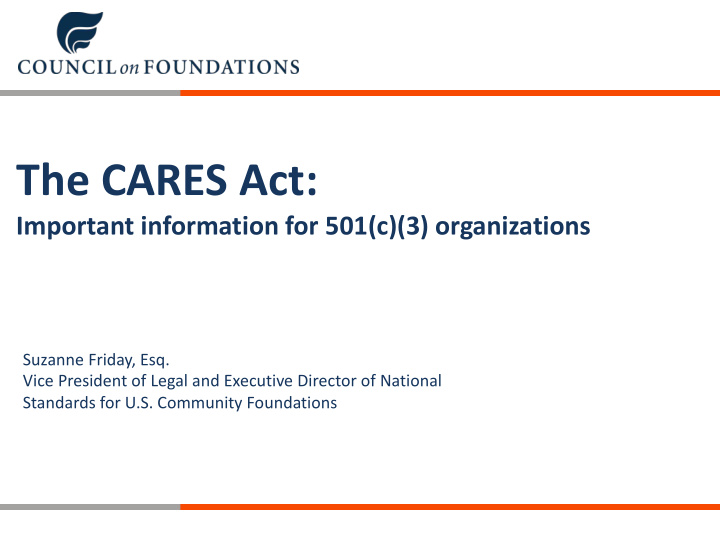



The CARES Act: Important information for 501(c)(3) organizations Suzanne Friday, Esq. Vice President of Legal and Executive Director of National Standards for U.S. Community Foundations
Agenda Today’s Presentation will provide an overview of: Relevant provisions in the CARES Act for Charities 1 Payroll Protection Program (PPP) Specifics 2 Coordinating Different Benefits 3
What’s in the CARES Act for Charities? The $2 Trillion CARES Act represents the largest-ever economic stimulus package in the United States. By comparison, the 2009 stimulus act included approximately $831 billion in appropriations. This bill is intended to address the economic fallout of the Coronavirus pandemic with a focus on helping businesses through loans and other assistance, and direct financial assistance to most American households. As businesses, charitable organizations can take advantage of several of the loan provisions in the Act. In addition, there are two provisions that address charitable giving. New above-the-line charitable deduction Increased percentage limitations for charitable deductions Payroll Protection Program (forgivable loans) SBA Emergency Economic Injury Disaster Loan (EIDL)
Provisions to Encourage Charitable Giving: Increased Percentage Limitations $300 Above-the-Line Charitable for Charitable Gifts Deduction • Suspends current 50%/60% AGI • Must be made in cash deduction limitation • Cannot be made to supporting • Corporate limit is increased organizations, donor advised from 10% to 25% funds or private foundations • No changes to PF limitations • Cannot be combined with an • 15% limit for food gifts itemized charitable deduction increased to 25% • $300 per return (so couples only • Donor advised funds and get $300) supporting organizations are • Not limited to charities working excluded directly on coronavirus
Emergency Economic Injury Disaster Loan (EIDL) Expansion of existing SBA emergency loans provides up to $2 million working capital loan at 2.75% interest with maximum 30- year repayment and payment deferral up to one year. Eligibility requirements: • Must be in existence on January 31, 2020 • Businesses with fewer than 500 employees • Cooperatives, ESOPs, and tribal small businesses with fewer than 500 employees • Sole proprietors • Independent contractors • Most private nonprofits • No personal guarantee and minimal documentation required • $10,000 advance “emergency grant” is available with no obligation to repay even if loan is not approved
Payroll Protection Act (PPP) - Forgivable Loans • New loans that are 100% SBA guaranteed and provide for 100% forgiveness under certain circumstances • Nonprofit and for-profit small businesses can apply • Apply through an SBA lender (application period began on April 3 and continues on first-come-first-serve basis) • Businesses with 500 or fewer employees in the United States • In operation on February 15, 2020 and paid salaries, employment taxes, independent contractor wages • Maximum loan is $10 million or 2X payroll formula (cannot include wages over $100,000)
Payroll Protection Act (PPP) cont. • Payroll costs include salaries, payment for vacation and sick leave, medical benefits, retirement, state and local taxes • Excludes federal employment taxes and any sick and family leave wages for which a credit was received under other COVID-19 programs • Independent contractors do not count as employees • Interest rate will be 1% with 2-year maturity • Repayment begins 6 months after disbursement but interest accrues during deferment • 100% loan forgiveness available (principal and accrued interest)
PPP Loan Forgiveness • Must use all loan proceeds for “forgivable purposes” • Must also maintain employee and compensation levels • Forgiveness depends on comparison of payroll and other costs (mortgage interest, rent and utilities) before February 15, 2020 with costs eight weeks after loan disbursement • However, not more than 25% can be attributable to non- payroll costs • SBA Interim Rule published last week has complete details REMEMBER: PURPOSE IS TO PROVIDE INCENTIVE TO KEEP EMPLOYEES EMPLOYED
Coordination of Different Benefit Programs Persons or entities who obtain a PPP loan and receive any forgiveness with respect to such loan are statutorily barred from also receiving an employee retention credit as well as barred from deferring payment with respect to their employer-side employment tax obligations. Persons or entities who receive an employee retention credit may also defer payment with respect to their employer-side employment tax obligations. In this way, the decision for a person or entity is whether to obtain forgiveness with respect to a PPP loan, or to receive an employee retention credit and defer the payment of employer-side employment tax obligations. The only exception to this either/or dynamic is where a person or entity obtains a PPP loan but seeks no forgiveness with respect thereto. In such a case, the person or entity can also receive an employee retention credit and deferral with respect to the payment of their employer-side employment tax obligations.
Recommend
More recommend